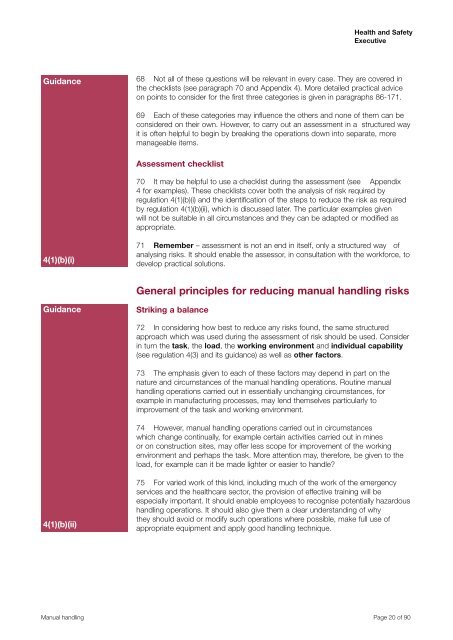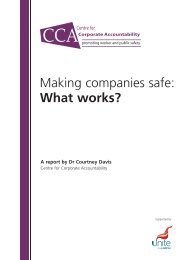Manual Handling Manual Handling Operations Regulations 1992 ...
Manual Handling Manual Handling Operations Regulations 1992 ...
Manual Handling Manual Handling Operations Regulations 1992 ...
Create successful ePaper yourself
Turn your PDF publications into a flip-book with our unique Google optimized e-Paper software.
Health and Safety<br />
Executive<br />
Guidance<br />
68 Not all of these questions will be relevant in every case. They are covered in<br />
the checklists (see paragraph 70 and Appendix 4). More detailed practical advice<br />
on points to consider for the first three categories is given in paragraphs 86-171.<br />
69 Each of these categories may influence the others and none of them can be<br />
considered on their own. However, to carry out an assessment in a structured way<br />
it is often helpful to begin by breaking the operations down into separate, more<br />
manageable items.<br />
Assessment checklist<br />
70 It may be helpful to use a checklist during the assessment (see Appendix<br />
4 for examples). These checklists cover both the analysis of risk required by<br />
regulation 4(1)(b)(i) and the identification of the steps to reduce the risk as required<br />
by regulation 4(1)(b)(ii), which is discussed later. The particular examples given<br />
will not be suitable in all circumstances and they can be adapted or modified as<br />
appropriate.<br />
4(1)(b)(i)<br />
71 Remember – assessment is not an end in itself, only a structured way of<br />
analysing risks. It should enable the assessor, in consultation with the workforce, to<br />
develop practical solutions.<br />
General principles for reducing manual handling risks<br />
Guidance<br />
Striking a balance<br />
72 In considering how best to reduce any risks found, the same structured<br />
approach which was used during the assessment of risk should be used. Consider<br />
in turn the task, the load, the working environment and individual capability<br />
(see regulation 4(3) and its guidance) as well as other factors.<br />
73 The emphasis given to each of these factors may depend in part on the<br />
nature and circumstances of the manual handling operations. Routine manual<br />
handling operations carried out in essentially unchanging circumstances, for<br />
example in manufacturing processes, may lend themselves particularly to<br />
improvement of the task and working environment.<br />
74 However, manual handling operations carried out in circumstances<br />
which change continually, for example certain activities carried out in mines<br />
or on construction sites, may offer less scope for improvement of the working<br />
environment and perhaps the task. More attention may, therefore, be given to the<br />
load, for example can it be made lighter or easier to handle?<br />
4(1)(b)(ii)<br />
75 For varied work of this kind, including much of the work of the emergency<br />
services and the healthcare sector, the provision of effective training will be<br />
especially important. It should enable employees to recognise potentially hazardous<br />
handling operations. It should also give them a clear understanding of why<br />
they should avoid or modify such operations where possible, make full use of<br />
appropriate equipment and apply good handling technique.<br />
<strong>Manual</strong> handling Page 20 of 90
















